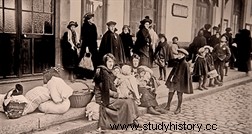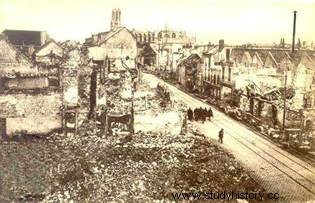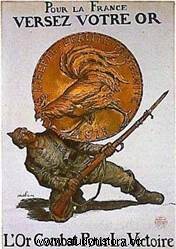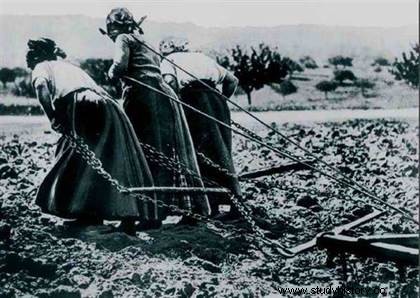 Civilians in World War I , like the “poilu”, experienced the conflicts both as spectators and actors, but much more often as protagonists, located at the heart of the First World War. The study of civilians was pushed into the background for decades, masked by the heroic acts of the "hairy" and the battles with resounding names still today. However, some researchers have only carried out their investigations on this category of French people who have lived through the “Great War” for a few years.
Civilians in World War I , like the “poilu”, experienced the conflicts both as spectators and actors, but much more often as protagonists, located at the heart of the First World War. The study of civilians was pushed into the background for decades, masked by the heroic acts of the "hairy" and the battles with resounding names still today. However, some researchers have only carried out their investigations on this category of French people who have lived through the “Great War” for a few years.
WWI civilians facing the front
From their geographical location, whether these civilians lived close to the front or whether they reside in the south of France, all experienced the war in one way or another. 'another one. Whether it be the abuses of the occupation or borrowings from war, a daily life totally disrupted and broken in a spirit of patriotic fervor in order to protect "the attacked nation" against an enemy who has become hereditary in the minds of the French, Germany.
 After the German breakthrough in August and September 1914 towards the Marne, many French were panicked, the information having been relayed very little in the countryside in which the majority of the French still reside. The ubiquitous press in the cities is much less so in the rural villages. Faced with this advance, a threat soon hovered over Paris, the capital. Due to a strategic flaw in troop movements, the German army opening a breach on its right flank, allowed the "French surge" and the famous episode of the Taxis de la Marne which nevertheless remains to be put into perspective in the sense that these vehicles requisitioned in the capital transported only a few thousand soldiers.
After the German breakthrough in August and September 1914 towards the Marne, many French were panicked, the information having been relayed very little in the countryside in which the majority of the French still reside. The ubiquitous press in the cities is much less so in the rural villages. Faced with this advance, a threat soon hovered over Paris, the capital. Due to a strategic flaw in troop movements, the German army opening a breach on its right flank, allowed the "French surge" and the famous episode of the Taxis de la Marne which nevertheless remains to be put into perspective in the sense that these vehicles requisitioned in the capital transported only a few thousand soldiers.
Joffre, generalissimo of the French army on the western front, decided to launch the counter-offensive and succeeded in repelling the Germans. These, a few kilometers north of Reims, fortified their positions, thus initiating "positional warfare" and trenches. The civilians, many of whom were not evacuated, became unwitting actors in the conflict. This was the case in 11 French departments, including the Marne and the Ardennes, which were particularly affected. Some civilians managed to escape, others were taken prisoner by the occupier.
In the occupied territories
The department most affected by the occupation during the "Great War" was the Ardennes department, occupied continuously for four years, subject to abuses, punishments and crimes Germans. These civilian prisoners were given the task of working for the occupier in order to ensure the supply of the rear and the German troops on the Front. These civilians worked, in particular, in the fields, or at least the fields remained in a state of being cultivated. Most of the departments of the North, North-East of France were also placed in the "red zone" at the end of the war, symbolizing the presence of dangerous zones due to unexploded ordnance, shells... .
The occupation was marked by the establishment of a Kommandantur established in the Ardennes at Charleville-Mézières. It was the nerve center of decisions concerning production quotas for the occupier, the requisition of all the materials necessary from near and far for the war.
Many civilians were also deported to concentration camps, from which many never returned due to deprivation and particularly difficult living conditions. Other civilians, on the contrary, were able to flee to the departments spared by the bombardments and the brutality of the Germans. Entire families left to find their loved ones in the South of France, a departure supported by the State. Some of these families during the 1914-1918 war will never return to their native village.
A war lived differently by other French civilians
At the antipodes of the lives of civilians, victims of the occupation and "uprooted" refugees, others have experienced the war with equally difficult propensities but with other conditions.
 In the rest of France, civilians, men, women and children, participated in the war through the through multiple efforts. An economic effort marked by war loans, in particular allowing financial mobilization from the rear in order to support the front. Touching the patriotic chord and in order to make the war loan a success, the State used propaganda as an instrument in its own right to mobilize the fatherland.
In the rest of France, civilians, men, women and children, participated in the war through the through multiple efforts. An economic effort marked by war loans, in particular allowing financial mobilization from the rear in order to support the front. Touching the patriotic chord and in order to make the war loan a success, the State used propaganda as an instrument in its own right to mobilize the fatherland.
The French people were "invited" to give their gold objects, their money in order to finance the front but even more, the victory. Indeed, each poster of war loan presented to the French, the vital necessity of the donations of money, by assuring the savers that it was about the best way to participate in the war effort and to get rich. . It was therefore in a Manichean vision of things that the war loan was presented, the first of which took place in November 1915 in a context where the idea of a "short war" withered away as the war drags on, costing more and more at the same time.
Beyond the financial effort, civilians had to work in the fields and factories in order to keep the country's economy running. The war caused a change in the French economy, creating a war economy based on the arms industry. The vast majority of factories are reconverted, for the manufacture of guns, shells or other. Place in which women were enjoined to work in order to replace the men who had gone to the front.
The image of women was profoundly transformed in the minds of the French, although the implementation of this transformation turned out to be less profound than what the situation of French society during the 1914-1918 war. Moreover, the women and children went to work in the fields in order to ensure the subsistence of the country and to supply the men on the front in exhausting and harsh conditions for the women and children.
The moral suffering of civilians during the First World War
Psychologically, the war was also trying for the civilian population. The husband gone to the front, was an omnipresent thought for the families. Waiting for possible news or a return most often transforming into mourning at the announcement of the soldier's death. Fear and anguish were an integral part of civilian life during the “Great War” in the case of civilians far from combat zones. The same goes, if not more, for the families close to the front, who may have lost their husbands, their homes and everything they owned before the war.
At the back, the return of the dead arouses religious fervor. God very quickly becomes an actor in the Great War. The general devotion is notably multiplied. We imagine God alongside the hairy ones on the forehead. “God is on your side,” we hear. The French in the rear pay homage to Joan of Arc, whom they represent dressed in the "horizon blue" uniform of the French army. Religious documents depicting prorogated French soldiers are increasingly common. The missals also refer to the battles, as evidenced by Abbé Coubé's "Missal du miracle de la Marne". The men at the front are also represented as "Christian and patriotic soldiers" alongside whom God is present.
 Ultimately, whether civilians lived under the German Occupation, near the front or in areas where the war did not impose its sufferings, the civilians underwent the violence and the horrors of the war that they are financial, social, psychological domain.... All lived the hard sufferings imposed by the exacerbated nationalism which provoked WWI. The "hairy" were central players in the "Great War", paying with their lives the tribute imposed by the war, but the civilians were also imposed this "blood tax" to achieve the objective set by the fatherland, Victory.
Ultimately, whether civilians lived under the German Occupation, near the front or in areas where the war did not impose its sufferings, the civilians underwent the violence and the horrors of the war that they are financial, social, psychological domain.... All lived the hard sufferings imposed by the exacerbated nationalism which provoked WWI. The "hairy" were central players in the "Great War", paying with their lives the tribute imposed by the war, but the civilians were also imposed this "blood tax" to achieve the objective set by the fatherland, Victory.
Bibliography
- ALARY Eric, The Great Civil War 1914-1919, Perrin, 2013.
- Chronicles of the First World War, by Jean-Paul Viart. Larousse, 2013.
